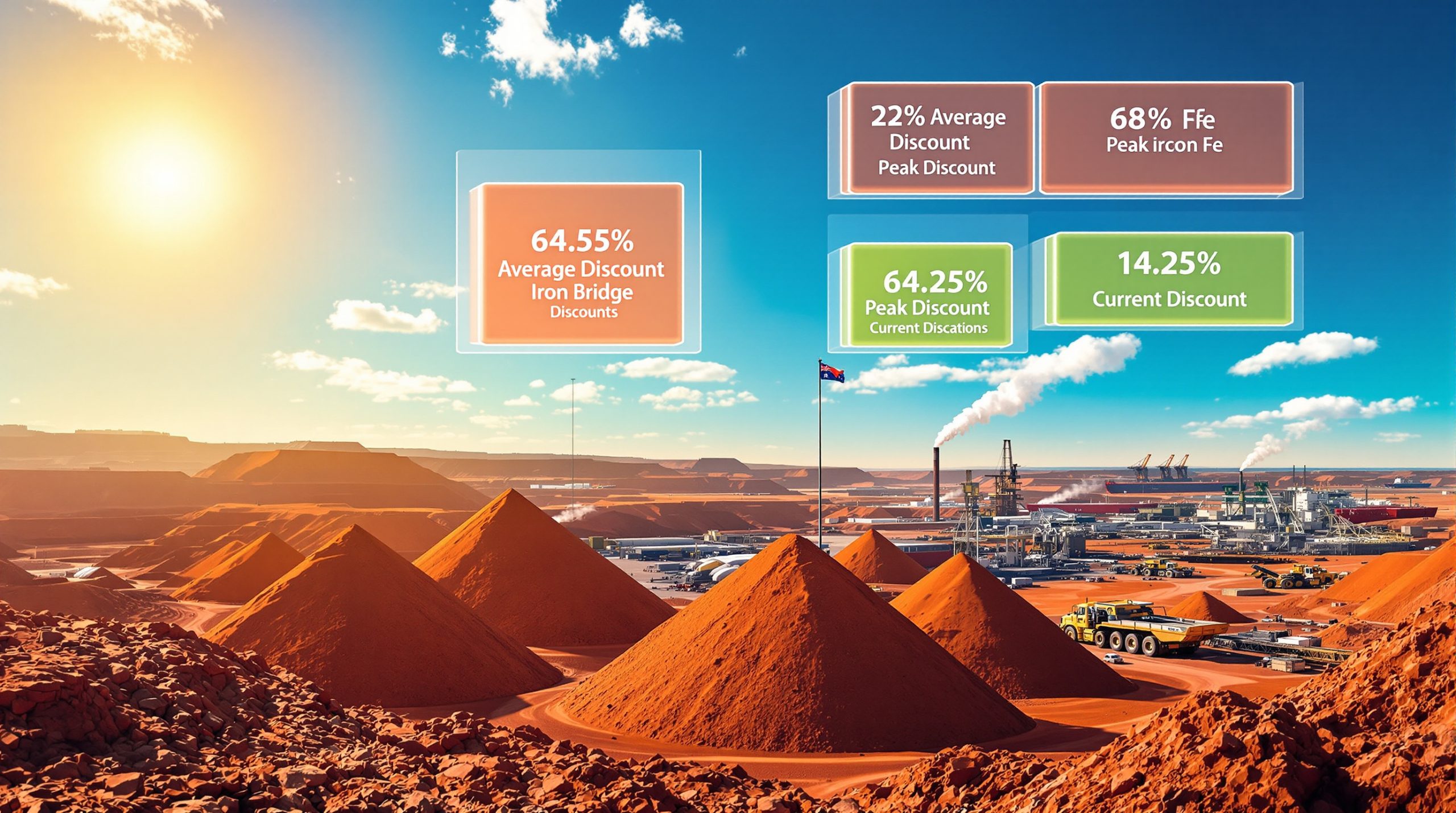What Made Newmont's Q3 2025 Results Beat Wall Street Expectations?
Newmont quarterly profit estimates record gold prices created exceptional conditions for the world's largest gold mining company to exceed Wall Street expectations despite facing significant operational challenges. The company delivered impressive financial results powered by unprecedented commodity pricing that transformed typical mining economics throughout the third quarter of 2025.
Record Gold Price Realisation Drives Revenue Growth
Newmont Corporation delivered exceptional quarterly results powered by unprecedented gold pricing conditions that transformed operational challenges into profitability victories. The world's largest gold mining company realised an average gold price of $3,539 per ounce during Q3 2025, representing a substantial 40.5% increase from the $2,518 per ounce achieved in the comparable 2024 period.
This dramatic price appreciation stems from macroeconomic uncertainty that has driven investors toward safe-haven assets throughout 2025. Furthermore, President Donald Trump's tariff policies and escalating geopolitical tensions have created sustained demand for precious metals as portfolio hedges against currency volatility and political instability.
The pricing environment enabled Newmont to generate total revenue of approximately $4.2 billion, substantially exceeding analyst projections despite production headwinds across key operations. This performance demonstrates how record gold prices analysis reveals that commodity price cycles can override operational challenges when timing aligns favourably with market conditions.
Earnings Per Share Performance Analysis
Newmont's financial execution delivered adjusted earnings per share of $1.71, crushing Wall Street consensus estimates of $1.43 by an impressive 19.6% margin. This earnings beat occurred during a quarter marked by significant production disruptions, highlighting the leverage mining companies achieve during favourable pricing cycles.
The substantial margin expansion reflects operational discipline combined with favourable market timing. With all-in sustaining costs (AISC) declining to $1,566 per ounce while realised prices reached record territory, Newmont achieved gross margins of approximately $1,973 per ounce during the quarter.
| Performance Metric | Q3 2025 | Q3 2024 | Change |
|---|---|---|---|
| Realised Gold Price | $3,539/oz | $2,518/oz | +40.5% |
| Adjusted EPS | $1.71 | N/A | Beat by 19.6% |
| AISC per Ounce | $1,566 | $1,611 | -2.8% |
| Gross Margin per Oz | ~$1,973 | ~$907 | +117% |
How Did Production Challenges Impact Newmont's Quarter?
Output Decline Across Key Operations
Despite strong financial results, Newmont experienced meaningful production headwinds that reduced gold output by 15% to 1.42 million ounces compared to 1.67 million ounces in the prior year period. This decline resulted from a combination of planned maintenance activities and operational transitions across the company's global portfolio.
The most significant impacts occurred at three key facilities:
• Peñasquito mine in Mexico: Scheduled maintenance disruptions affected quarterly throughput
• Lihir mine in Papua New Guinea: Planned maintenance activities reduced operational capacity
• Ahafo South operation in Ghana: Completion of mining at the Subika open pit in July marked the end of a production phase
These operational challenges reflect the natural rhythm of large-scale mining operations, where maintenance schedules and mine life transitions create periodic production volatility. Moreover, the Subika completion particularly represents a planned transition between mining phases rather than operational failure.
Operational Efficiency Metrics Despite Lower Volumes
Remarkably, Newmont achieved cost improvements concurrent with production declines, demonstrating operational flexibility during challenging periods. All-in sustaining costs decreased 2.8% to $1,566 per ounce, contradicting typical mining economics where lower volumes compress margins through fixed cost deleverage.
This counterintuitive performance indicates several positive operational trends:
• Enhanced operational efficiency through technology adoption and process optimisation
• Strategic portfolio management prioritising higher-margin deposits during capacity constraints
• Successful cost management initiatives offsetting inflationary pressures across labour and energy inputs
• Integration benefits from the Newcrest acquisition creating operational synergies
Consequently, the cost performance suggests Newmont's management team effectively navigated production challenges while maintaining financial discipline, a critical capability during commodity cycles.
What Strategic Moves Are Shaping Newmont's Financial Position?
Post-Newcrest Acquisition Integration Progress
Newmont's current operational landscape reflects ongoing integration efforts following the company's $17.14 billion acquisition of Australian miner Newcrest, one of the largest mining transactions in recent industry history. The strategic rationale encompassed geographic diversification, reserve replacement, and operational synergies through portfolio consolidation.
The integration process has progressed through several phases:
• Asset rationalisation: Non-core assets divested to strengthen balance sheet positioning
• Debt reduction initiatives: Proceeds from asset sales applied to reduce acquisition-related financing
• Operational optimisation: Portfolio consolidation creating efficiency opportunities
• Geographic diversification benefits: Enhanced exposure to key mining jurisdictions including Australia and Papua New Guinea
Management characterised the Q3 production decline as part of broader restructuring efforts, indicating deliberate strategic choices rather than operational distress. Newmont beats quarterly profit estimates demonstrates this approach prioritises long-term portfolio optimisation over near-term production maximisation.
Capital Allocation and Investment Pipeline
Newmont announced plans for increased capital expenditure in 2026 to advance key development projects, signalling a transition from integration and deleveraging phase to growth investment phase. The primary focus areas include infrastructure and expansion opportunities at proven assets.
Priority capital allocation targets:
• Cadia tailings infrastructure development: Long-life, low-incremental-cost expansion opportunity leveraging existing operational framework
• Red Chris expansion evaluation: Potential expansion under assessment with decision criteria based on project economics and market conditions
• Operational infrastructure upgrades: Technology integration and efficiency improvements across mining operations
• Maintenance capital requirements: Sustaining investments to maintain production capacity at core assets
This capital allocation strategy reflects management confidence in sustained commodity pricing and operational cash flow generation capability.
How Are Market Conditions Supporting Gold Mining Profitability?
Global Economic Factors Driving Gold Demand
The exceptional gold price environment during Q3 2025 reflects fundamental macroeconomic drivers that extend beyond typical market cycles. In addition, historic $3000 gold surge throughout 2025 resulted from convergent factors creating sustained safe-haven demand patterns.
Primary demand drivers include:
• Currency devaluation concerns: Dollar weakness and emerging market currency volatility driving precious metals demand
• Geopolitical risk premiums: International tensions creating portfolio hedging requirements
• Policy uncertainty: Trade policy changes and regulatory shifts increasing economic uncertainty
• Inflation hedging demand: Real interest rate considerations supporting gold allocations
Furthermore, the current market environment demonstrates gold's traditional role as a monetary asset during periods of elevated uncertainty, with price appreciation reflecting fundamental demand rather than speculative positioning.
Mining Industry Cost Structure Evolution
While gold prices reached record levels, the mining industry simultaneously managed inflationary cost pressures across operational inputs. Labour and energy cost inflation challenged profit margin expansion despite favourable commodity pricing.
Industry Insight: The 2.8% reduction in Newmont's all-in sustaining costs during an inflationary environment demonstrates operational excellence that may distinguish leading miners from industry peers during commodity cycles.
Cost management strategies across the sector include:
• Technology integration: Automation and digitalisation improving operational efficiency
• Supply chain optimisation: Strategic procurement and logistics management reducing input costs
• Energy efficiency initiatives: Renewable energy adoption and power cost management
• Operational consolidation: Portfolio optimisation eliminating higher-cost production sources
What Does Leadership Transition Mean for Newmont's Future?
New CEO Appointment Significance
Newmont appointed Natascha Viljoen as Chief Executive Officer in September 2025, marking a historic milestone as the company's first female CEO in its 130-plus year operational history. Viljoen succeeded Tom Palmer, who retired after serving 12 years in the leadership role during multiple commodity cycles and major strategic transactions.
Palmer's tenure encompassed significant industry developments:
• Commodity cycle management: Leadership through low-price environment (2015-2016) and subsequent recovery
• Strategic transactions: Oversight of major M&A activity including Goldcorp merger and Newcrest acquisition
• Operational restructuring: Portfolio optimisation and operational efficiency improvements
• Technology adoption: Digital transformation and automation implementation across operations
The succession timing during earnings announcement suggests planned, orderly transition rather than emergency leadership change, indicating continuity in strategic direction.
Strategic Vision Under New Management
Viljoen's appointment occurs during a critical period combining post-acquisition integration with favourable market conditions. The leadership transition provides opportunity to establish strategic priorities for the next operational phase.
Expected focus areas under new leadership:
• Operational excellence: Continued emphasis on cost discipline and efficiency improvements
• Technology integration: Advanced mining technologies and digitalisation across operations
• Sustainability initiatives: Environmental and social governance alignment with investor expectations
• Portfolio optimisation: Strategic asset allocation and development prioritisation
• Stakeholder engagement: Community relations and regulatory compliance in key jurisdictions
Why Did Newmont Shares Decline Despite Strong Earnings?
Market Reaction Analysis
Despite exceeding profit expectations by nearly 20%, Newmont shares declined 2.5% in extended trading following the Q3 2025 results announcement. This seemingly counterintuitive market reaction reflects sophisticated investor analysis focusing on forward-looking indicators rather than historical performance metrics.
Factors contributing to negative market response:
• Production volume concerns: 15% output decline raising questions about operational trajectory
• Forward guidance focus: Investor attention on 2026 capital expenditure increases and production outlook
• Commodity price sustainability: Market scepticism regarding sustained record gold pricing
• Valuation considerations: Stock price appreciation throughout 2025 creating elevated expectation levels
This market behaviour demonstrates the complexity of mining equity valuation, where investors simultaneously evaluate backward-looking financial performance and forward-looking operational indicators. However, gold stock market dynamics suggest these reactions are typical during peak commodity cycles.
Analyst Sentiment and Valuation Considerations
The earnings beat occurred within a broader context of elevated gold mining equity valuations throughout 2025, creating challenging comparison benchmarks for investor expectations. Mining stocks typically exhibit high correlation with underlying commodity prices, but operational execution becomes increasingly important during peak pricing cycles.
Investment community considerations:
• Price dependency risk: Concern over earnings volatility if gold prices normalise from record levels
• Capital expenditure implications: 2026 spending increases potentially pressuring near-term cash flow generation
• Production recovery timeline: Uncertainty regarding maintenance completion and output normalisation
• Competitive positioning: Relative performance versus other major gold mining companies
What Are the Investment Implications for Gold Mining Stocks?
Sector Performance Drivers
Newmont's Q3 2025 results provide insights into broader gold mining sector dynamics during exceptional commodity pricing environments. The company's ability to expand margins while managing production challenges demonstrates operational resilience that may distinguish quality operators during market cycles.
Key sector investment themes:
• Leverage to commodity prices: Mining equities providing amplified exposure to gold price movements
• Operational differentiation: Cost management and efficiency improvements creating competitive advantages
• Geographic diversification: Political and regulatory risk distribution across mining jurisdictions
• Reserve quality and longevity: Asset base sustainability supporting long-term value creation
• Technology adoption: Digital transformation improving operational efficiency and cost structures
Consequently, gold price forecast 2025 continues showing upward momentum that supports mining sector valuations.
Risk Factors for Mining Investment Decisions
While favourable commodity pricing creates opportunities, mining investments carry inherent risks requiring careful evaluation by potential investors.
Primary risk considerations:
• Commodity price volatility: Gold price fluctuations directly impacting earnings and valuation
• Operational risk exposure: Mine development, maintenance, and geological challenges affecting production
• Regulatory environment changes: Permitting, taxation, and environmental compliance costs
• Currency fluctuation impacts: International operations subject to foreign exchange rate movements
• Capital intensity requirements: Mining operations requiring substantial ongoing investment
• Environmental and social compliance: Increasing regulatory and stakeholder expectations
Disclaimer: Mining investments carry significant risks including commodity price volatility, operational challenges, and regulatory changes. Investors should conduct thorough due diligence and consider their risk tolerance before making investment decisions.
How Do Newmont's Results Compare to Industry Peers?
Competitive Positioning Analysis
Newmont's Q3 2025 performance provides benchmarking opportunities against other major gold mining companies navigating similar market conditions. The company's market share maintenance despite production decline demonstrates competitive positioning strength during operational challenges.
Competitive advantages demonstrated:
• Scale benefits: Large-scale operations providing operational flexibility and cost advantages
• Portfolio diversification: Geographic and geological diversity reducing single-asset risk exposure
• Financial strength: Balance sheet capacity supporting strategic investments and operational challenges
• Technical expertise: Mining and processing capabilities enabling complex project development
The company's ability to reduce costs while peers potentially faced similar inflationary pressures suggests operational excellence relative to industry standards. Moreover, Newmont reports third quarter results show improved guidance metrics.
Industry-Wide Trends and Benchmarking
Several trends evident in Newmont's results reflect broader industry dynamics affecting gold mining companies globally during 2025.
Sector-wide patterns:
• Technology integration acceleration: Digital mining technologies becoming competitive necessities
• Environmental compliance emphasis: Sustainability initiatives increasingly affecting operational costs and approvals
• Consolidation activity: M&A transactions reshaping industry structure and competitive landscape
• Supply chain optimisation: Cost management initiatives addressing inflationary input pressures
• Regulatory complexity: Increasing compliance requirements across key mining jurisdictions
What Should Investors Watch for in Future Quarters?
Production Recovery Timeline Expectations
Future quarterly results will likely depend heavily on production normalisation following Q3 2025 maintenance activities and operational transitions. Investors should monitor specific operational milestones to assess trajectory changes.
Key monitoring points:
• Peñasquito maintenance completion: Timeline for resumed full production capacity in Mexico
• Lihir operational status: Papua New Guinea facility returning to normal throughput levels
• Ahafo South transitions: Next development phase following Subika open pit completion
• Quarterly output trends: Sequential production volume changes indicating operational recovery
• Cost trajectory monitoring: AISC performance during production volume recovery
Market Condition Monitoring Points
Given the significant impact of gold pricing on quarterly results, commodity market conditions remain critical variables for future performance assessment. Furthermore, gold market trends 2025 indicate continued demand surges.
Market variables requiring attention:
• Gold price sustainability: Whether record pricing levels can be maintained through 2026
• Macroeconomic policy impacts: Federal Reserve policy, inflation trends, and currency movements
• Geopolitical risk evolution: International tensions affecting safe-haven demand patterns
• Central bank purchasing: Official sector gold acquisition patterns supporting price floors
• Mining supply dynamics: Global production trends and new project development affecting market balance
Frequently Asked Questions:
Q: What was Newmont's actual earnings performance versus Wall Street estimates?
A: Newmont reported adjusted earnings of $1.71 per share, significantly exceeding analyst consensus estimates of $1.43 per share, representing a 19.6% earnings beat.
Q: How significant was the gold production decline in Q3 2025?
A: Gold production decreased 15% to 1.42 million ounces compared to 1.67 million ounces in the previous year's quarter, primarily due to planned maintenance and operational transitions.
Q: What specific factors caused Newmont's production challenges?
A: The production decline resulted from planned maintenance at Peñasquito (Mexico) and Lihir (Papua New Guinea) mines, plus completion of mining at the Subika open pit at Ahafo South operation.
Q: Why did investors react negatively despite the strong earnings beat?
A: The 2.5% after-hours stock decline likely reflected investor concerns about production volume trends, 2026 capital expenditure increases, and questions about gold price sustainability rather than celebrating the quarterly earnings performance.
Q: How did record gold prices impact Newmont's financial results?
A: Newmont quarterly profit estimates record gold prices enabled the company to realise an average gold price of $3,539 per ounce in Q3 2025, up 40.5% from $2,518 per ounce in the prior year, enabling substantial margin expansion despite production headwinds.
Further Reading:
Investors seeking additional insights into Newmont quarterly profit estimates record gold prices and mining sector analysis can explore quarterly earnings reports, industry research publications, and commodity market analysis from established financial institutions for comprehensive market context and investment guidance.
Looking to Capitalise on Mining Discovery Opportunities?
Discovery Alert's proprietary Discovery IQ model delivers instant notifications on significant ASX mineral discoveries, empowering investors to identify actionable opportunities before the broader market reacts. Explore how historic mineral discoveries have generated exceptional returns by visiting Discovery Alert's dedicated discoveries page, then begin your 30-day free trial to position yourself ahead of the next major breakthrough.




